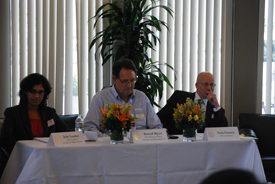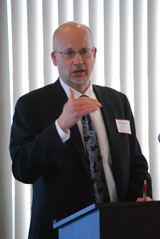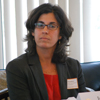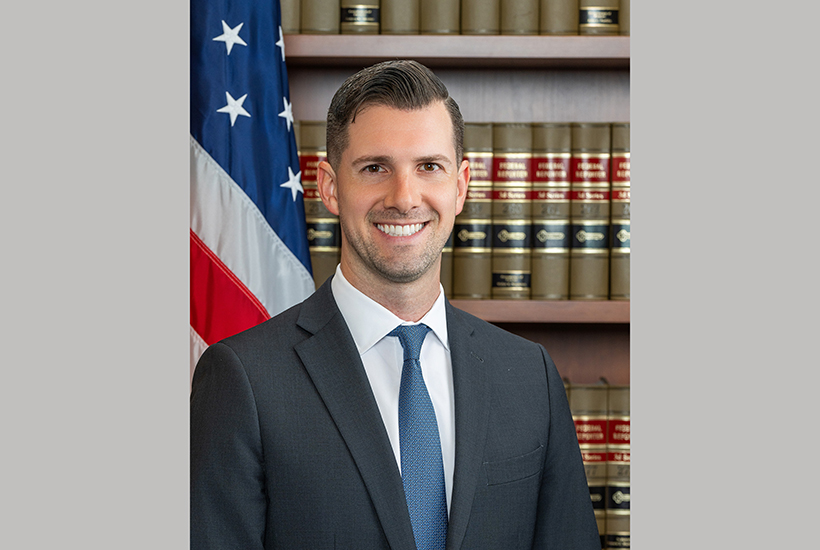Experts Discuss Policy's Past, Future
by
Darren Schenck
High emotions. Disregard of facts. Changing demographics. Unclear laws. Inconsistent adjudication.
These are just some of the challenges facing anyone seeking to reform the nation’s immigration policy, according to two panels of experts at the 2011 Southern California Review of Law and Social Justice Symposium, held March 9 at USC Law. Titled “Fundamentally Broken? The Past, Present, and Future of U.S. Immigration Policy,” the event covered the most pressing problems of immigration policy, as well as proposals for reform.
Prof. Niels Frenzen, director of USC Law’s Immigration Clinic, opened with a brief history of immigration policy, which he said was basically non-existent until the late 19th century.
 |
| Prof. Niels Frenzen |
“We have been historically a country of open borders,” Frenzen said. “As a young country, we encouraged immigration. There were checks, in that it was difficult to get here, but there were no legal checks.”
One of the earliest federal laws dealing with immigration, the Naturalization Act of 1790, allowed free white people who had been in the U.S. for two years to naturalize and acquire citizenship, according to Frenzen. In the late 1800s, the government began to impose restrictive immigration laws whose purpose was to keep out “convicts, prostitutes, idiots, lunatics and paupers.”
In 1882, a series of laws enacted by Congress collectively referred to as the Chinese exclusion laws effectively barred Chinese immigrants from entering the U.S.
“The Chinese faced slurs about not assimilating, speaking English or practicing our religion,” Frenzen said. “It’s a very familiar debate.”
Eventually, the U.S. Supreme Court ruled that Congress has the plenary power to make whatever immigration laws it sees fit, Frenzen said.
Prof. Dowell Myers, director of the Population Dynamics Research Group at the USC School of Policy, Planning, and Development, then spoke about the immigration debate in terms of population trends. He said the imminent problems attributed to immigration have nothing to do with immigrants but with what he called the “Baby Boomer tsunami.”
Underlining his point, Myers said that in the U.S. since 1970, there have been about 24 seniors nationally per 100 working-age residents.
“We take this ratio for granted,” he said. “But it goes up to 50 seniors per 100 working-age residents over the next 20 years.”
Myers reminded the audience that the U.S. is home to 78 million Baby Boomers, and that politicians don’t address this subject.
“This is the problem. It drives a whole lot of crises,” he said. “Social Security is the least of it. Healthcare is a much bigger deal.”
 |
| Judy London, Prof. Dowell Myers, Prof. Frenzen |
Myers said the U.S. needs more workers and taxpayers to care for the elderly, not fewer. He also demonstrated that, as they age, immigrants earn more and buy homes, and their children pursue education.
“Do we want them? Do we need them? You bet we do.”
Judy London, directing attorney of Public Counsel’s Immigrants’ Rights Project, spoke in detail about the current state of immigration law. Her work focuses on asylum seekers, primarily victims of crime and domestic violence.
“Asylum-seekers often are victims of state-sponsored torture, but somehow they’re less likely than victims of domestic violence to get it,” she said.
London said the biggest changes in immigration policy came about under the Illegal Immigration Reform and Immigrant Responsibility Act of 1996, passed during the Clinton Administration. The law requires detention for violators of immigration law but provides for no increase in access to counsel. It also requires that illegal immigrants show evidence of exceptional hardship to avoid deportation, a standard that is exceedingly difficult to meet. Finally, it eliminated section 245(i), so that even if an immigrant married an American citizen, that wouldn’t guarantee that he or she could stay in the country.
“It’s really about punishing the immigrant who enters illegally,” London said.
The Honorable Bruce J. Einhorn, a retired federal immigration judge, focused on the need for reform in asylum adjudication.
“In no area of immigration law adjudication do you see as much of a dramatic difference among judges than in decisions regarding asylum applications,” he said.
Einhorn said that culture has become the major challenge in assessing the credibility of asylum applicants in the United States.
“People in different cultures think differently,” he said. “Think how a Muslim woman from South Asia will feel in relating a story of physical abuse to a male judge, when she has never previously spoken to a male to whom she is not related.”
He said adjudicating asylum cases is especially difficult in a system that has no civil Gideon rule.
“There is no provision for free expert witness testimony, either, e.g., therapists, political scientists, and experts on country conditions who might come to court and discuss the general law macro issues.
“My proposal is that we ... should have a separate U.S. asylum court,” Einhorn concluded.
Karen Tumlin, managing attorney for the National Immigration Law Center’s Los Angeles office, spoke at length about Arizona’s controversial immigration law, SB 1070.
“First and foremost, one of the goals is to create a state-wide policy of ‘attrition through enforcement,’” Tumlin said. “It’s a massive scheme of interlocking provisions that work together to create that end.”
Tumlin said the state law is at odds with the notion that the federal government reigns supreme over immigration. She also explained how the law mandates that if a local police officer, in the course of any lawful stop, develops a “reasonable suspicion” that the person was “unlawfully present in the United States,” he or she must take reasonable steps to verify the immigration status of that person.
“How does one get ‘reasonable suspicion?’” she asked. “How does a local cop verify legal status?”
Tumlin described the National Immigration Law Center’s lawsuit.
“We are claiming the law violates the supremacy clause and is federally pre-empted,” she said.
How did we get here? she asked.
“There is tremendous frustration on the part of states with the status quo,” she said. “We are now at the highest level of immigration enforcement in the country’s history. Under President Obama, there are more deportations happening than at any point in U.S. history. There is more money being spent on border defense, more planes, drones and border walls.”
Dr. Roger Pilon of the Cato Institute was the final panelist to speak and, as “the only man of the right here,” presumably he would be presenting the “other side of this issue.”
“Well, that’s not the case,” he said. “We have a real illegal immigration problem in this country, and to my mind, the way you solve the problem of illegal immigration is to make immigration legal.”
A political appointee of the Reagan administration, Pilon was the first director of the Justice Department’s Asylum Policy and Review Unit.
“The real problem is to distinguish the legitimate asylum-seekers from the fraudulent asylum-seekers,” he said.
Pilon observed that although critics complain of mass immigration, today’s immigration numbers are comparable to those throughout U.S. history.
“Since 2000, the U.S. has admitted an average of one million legal immigrants a year, or an immigration rate of 3.5 per 1,000 residents,” he said. “This ratio was 9.4 to 10.5 in previous peak decades.”
Pilon said that without immigration, the growth of the U.S. labor force would decline toward zero during the next two decades. He also distinguished skilled workers, who typically immigrate using H-1B visas, from unskilled workers, who largely enter illegally.
He also observed that as recently as the early 1960s, half of the adult Americans in the workforce were high-school dropouts, compared with less than seven percent today.
“A better-educated labor force is a profoundly positive development, but it also means that fewer workers are willing to claim the still-growing number of jobs in our economy that require few skills and minimal formal education,” he said. “Immigrants fill that growing gap in the labor market.”
Southern California Review of Law and Social Justice (RLSJ) is dedicated to bringing attention to important issues of social justice and equality, and to publishing timely and intellectually substantive scholarly works. Additionally, each year, RLSJ hosts a symposium to highlight and facilitate scholarly discussions on an important topic pertaining to social justice. Last year, the symposium focused on the topic of Proposition 8 and gay marriage rights.



















